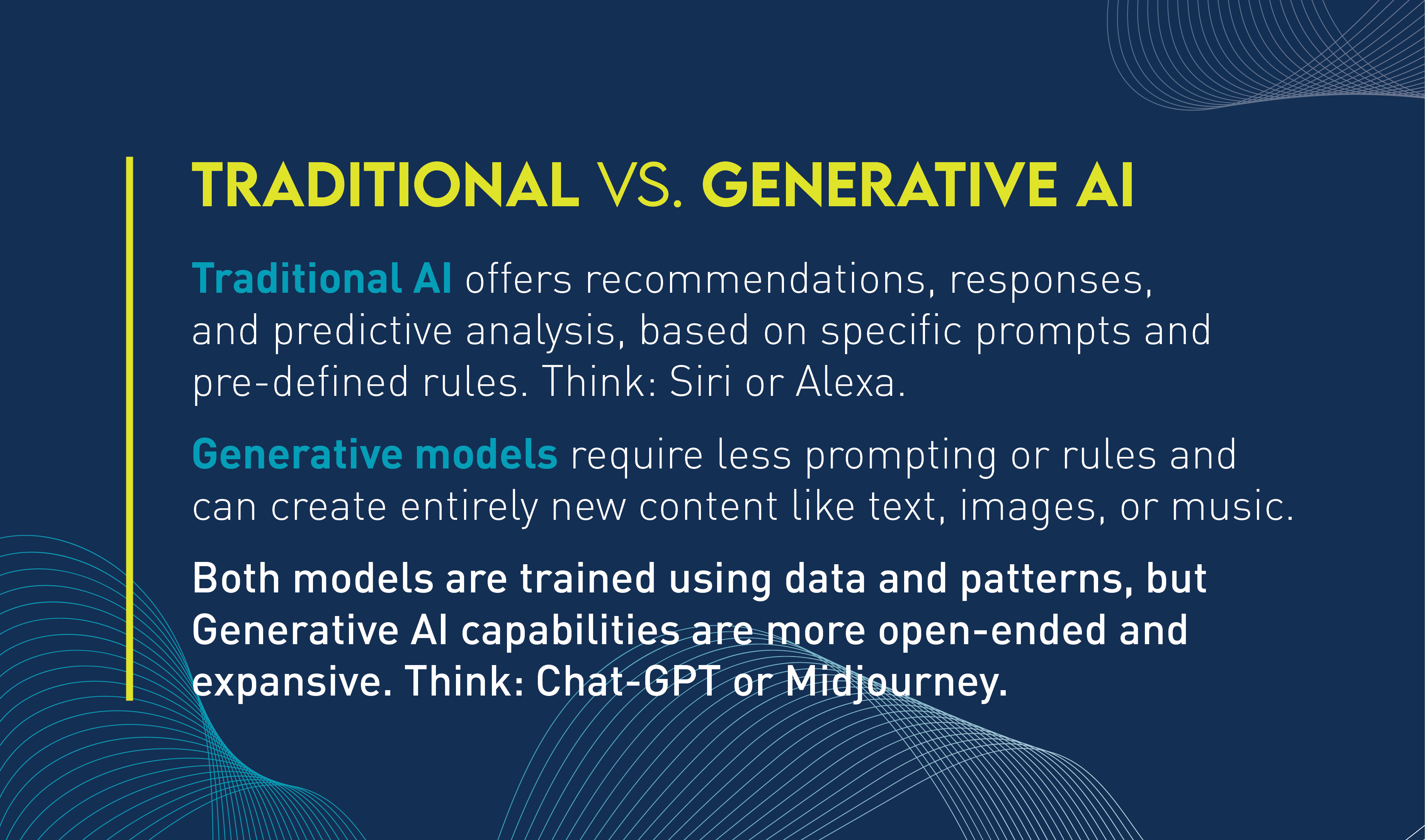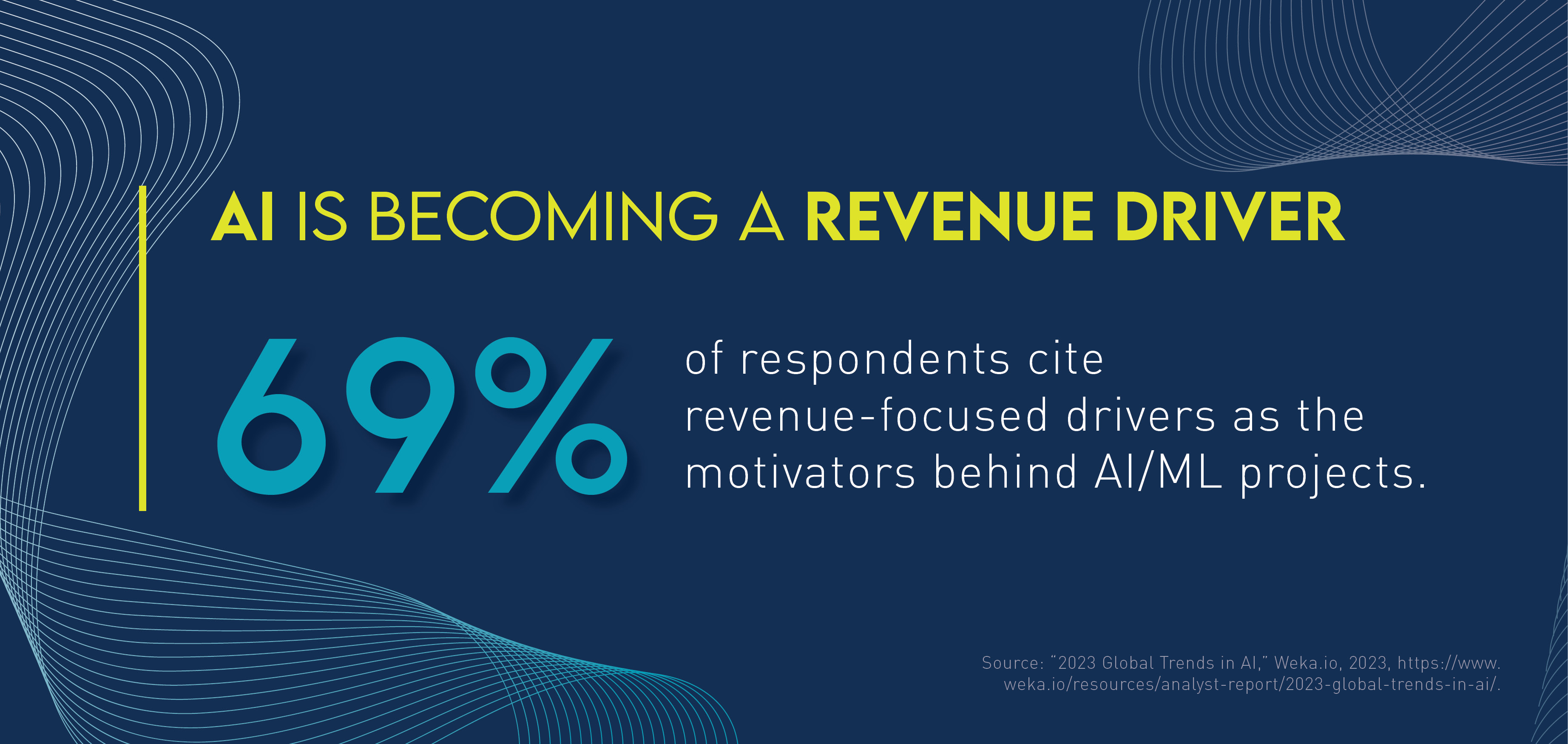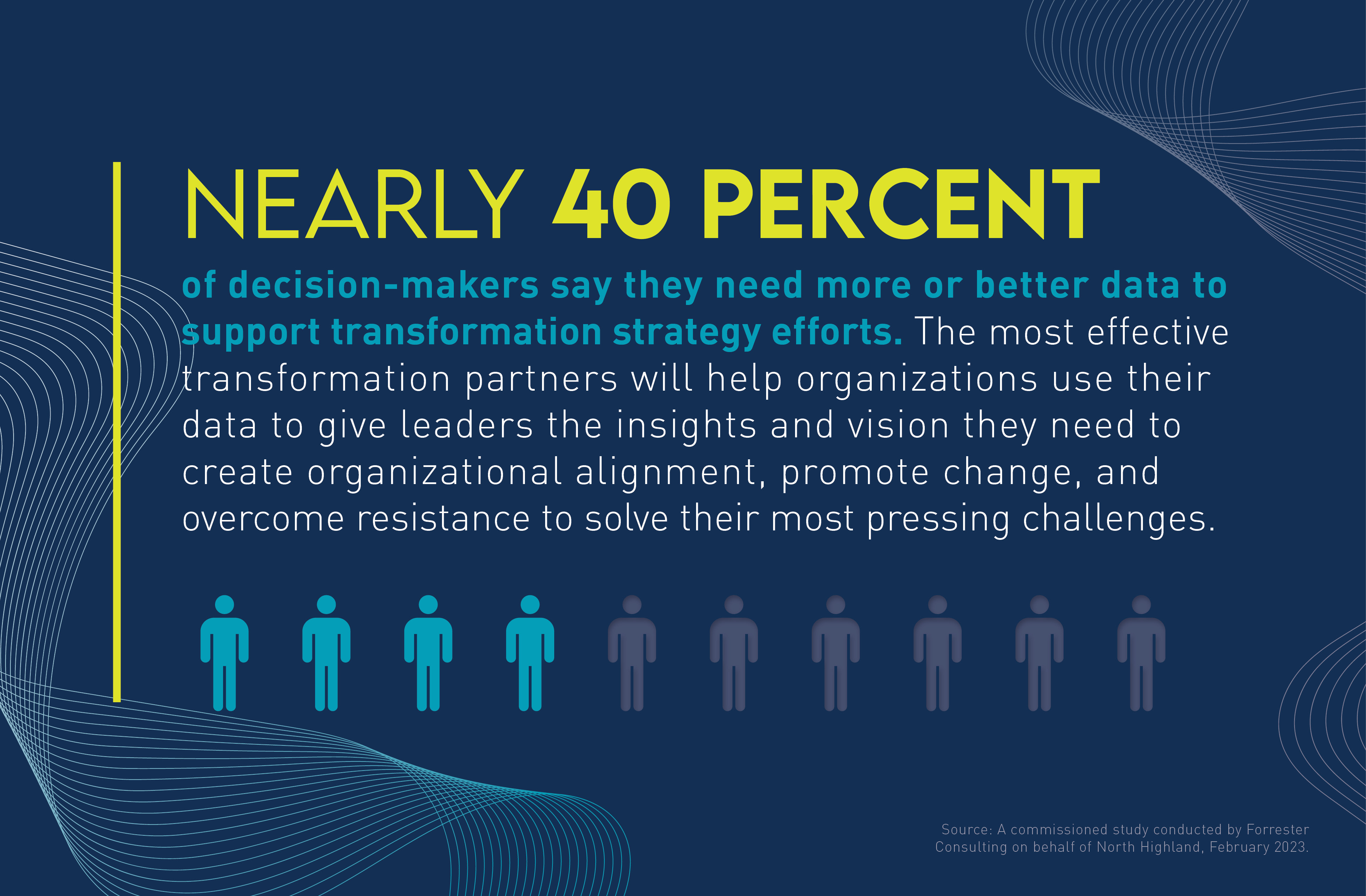Artificial Intelligence (AI) has permeated many corners of modern, industrialized society, helping us build our grocery lists, set reminders, and discover new artists. It has subtly become an integral part of many facets of affluent culture, leaving few aspects untouched. In fact, its expected influence is so profound that it is projected to make a substantial 21 percent net increase to the U.S. GDP by 2030.
While many of us may be familiar with AI-powered virtual assistants like Amazon’s Alexa and Apple’s Siri, new applications of AI seemingly pop up every day. Just open a Spotify application and you’ll now find an AI DJ that serves up personalized playlists.
"According to S&P Global Market Intelligence’s 2023 Global Trends in AI Report published in August, 69 percent of surveyed organizations have at least one AI project in production."
But while AI is becoming commonplace in our personal lives, when it comes to adopting and integrating AI solutions into our business, there is an undisputed (often painful) learning curve. Somewhere between 60-80 percent of AI projects do not deliver expected value.

While many businesses have grappled with achieving the desired levels of accuracy and effectiveness from these tools, this should not serve as a deterrent. On the contrary, we firmly believe that embracing AI remains a crucial step for every organization aiming to remain competitive and keep pace with the continuous transformation and ever-evolving demands of today's world.
To contribute to the GDP growth noted above, your organization needs to do much more than explore—you’ll need to create an AI-enabled enterprise.
So, what makes some businesses capable of capitalizing on the promise of AI to drive transformation? And what differentiates an AI-enabled enterprise? To begin answering these questions, let’s take a look at what may have been the first AI-enabled enterprise: Amazon.
A LOOK BACK AT AMAZON’S AI JOURNEY
There is a lot that can be learned from Amazon’s AI journey. Pitched and approved through CEO Jeff Bezos’ signature “six-pager” proposal vehicle, AI-fueled products, systems, and experiments began popping up across Amazon roughly a decade ago. Some of these AI applications involved rethinking current projects, like the company’s robotics efforts and its huge data center business, Amazon Web Services (AWS).
Others involved exploring entirely new businesses, like a voice-based home appliance that would become the Echo. But they were all being designed and deployed in segregated silos across the company. And the company’s culture of secrecy and ruthless protection over innovation—referred to as “single-thread ownership” in Amazon-speak—was hampering its ability to learn from early trials, share best practices, attract top AI talent, and gain momentum.
The subsequent development of Alexa was just as important to the inner workings of Amazon as it was to consumers—if not more so. Teams across the company began to realize that Alexa could be a useful voice service for their pet projects, and Amazon’s AI-enabled flywheel began to pick up speed as the culture was driven to collaborate across functions with increasingly connected Alexa-fueled innovations. Today, the company’s AI expertise is distributed across many teams, with a central unit dedicated to enabling and growing company-wide competence in AI and machine learning.
The company now uses AI to speed up product deliveries by minimizing the distance between its products and customers. It’s testing the use of generative AI to summarize product reviews, giving people an overview of what shoppers like and don’t like about a product, and is increasing personalization in the form of more advanced product recommendations.
Amazon had many of the building blocks in place to harness AI, but it was the cross-departmental collaboration and the courage to change its ways of working, enabled by a centralized function, that has really made AI stick.
The organizations of today that also aspire to become AI-enabled should take their cues from Amazon's AI journey. Those who are exceptional in their ability to build ethical, sustainable design into their AI strategies from the beginning (as opposed to recovering from situations gone wrong) will succeed.
In the first part of this blog series, we’ll begin to uncover what sets an AI-enabled organization apart from the pack. We’ll explore five key principles that allow a business to tap into AI as a catalyst for transformation. We call these “AI’s five first”:
- Lead with people
- Establish trust
- Democratize access
- Start a movement
- Learn
AI Principle #1: Lead with People
All the six-pagers and AWS engineers in the world won’t ensure that your AI-enabled solutions are adopted and optimized. Your people will.
Unlocking the power of AI requires a deliberate focus on the human aspect of human-machine partnerships. This goes beyond just implementing and deploying AI technologies; it requires actively involving and empowering employees throughout the entire AI journey.
Involving your employees in identifying early AI opportunities, prioritizing inclusive and user-centric design, and establishing ongoing feedback loops are all critical to making AI a success in your business.
While AI can help you rationalize different market entry points, it can't determine the market opportunities you should pursue. That's where input from people becomes crucial. Technical solutions and data can only take you so far; a human touch is still necessary because people are unpredictable. Your employees' domain expertise and intimate understanding of your business processes make them valuable contributors in identifying areas where AI can bring significant value.
Below are strategies for leading with people:
- Provide your people with channels to contribute their ideas, from emails and pulse surveys to focus groups, a dedicated Slack channel, the Microsoft Teams Employee Ideas app—anything that encourages open discussion and feedback. This allows you to tap into their knowledge and creativity and facilitate a more comprehensive and nuanced understanding of where AI can be effectively applied. Co-creation design sessions, which often take the form of facilitated workshops, are another particularly effective channel, as they help ensure that employees have a say in designing and creating things that affect them.
- Collect a diverse range of perspectives when co-creating, including those of different departments, roles, and backgrounds. This will help you ensure that the AI solutions you develop are designed to address the needs and challenges faced by various stakeholders. Taking this approach not only leads to more effective solutions but also fosters a sense of ownership among your employees, increasing their engagement and commitment to AI initiatives.
- Establish ongoing feedback loops, which are essential to continuously improving and refining AI solutions. By actively seeking feedback from your employees and incorporating their insights into the development process, you create a culture of continuous learning and iteration.
- Don't leave your culture behind. Despite the technological nature of AI, designing, building, and implementing AI solutions requires significant human effort, investment in knowledge development, and a culture ready to fully leverage AI's potential. Just like cultivating a garden, culture cultivation is an ongoing process. There's no quick magic trick to change culture overnight, especially in the uncertain areas of AI's unknowns. It requires planting seeds, patient tending, and constant care over many months. However, the hopeful outcome can be an amazing bounty.
AI Principle #2: Establish Trust
The potential of AI to transform industries is immense, but tapping into its advantages requires organizations to address widespread fears and concerns associated with its adoption. Creating a supportive environment is essential for helping individuals, teams, and the organization as a whole trust and integrate AI technologies.
Recent surveys reveal that 77 percent of people have concerns about job losses due to AI, suggesting a prevalent anxiety about its effect on employment. These fears are often compounded by other concerns, such as AI's potential to generate misleading information, introduce biases, or raise ethical and privacy issues.
Much of the apprehension surrounding AI, however, originates from misunderstandings and misconceptions about what the technology can—and cannot—do. Addressing these gaps in knowledge is crucial for alleviating fears and fostering a more informed perspective on the role and potential of AI.
Here are some approaches for demystifying AI and building trust:
- Invest in and prioritize education and awareness. When employees and leaders understand AI systems and believe in their capabilities, they are more willing to trust and collaborate with the technology and leverage its strengths. This collaboration can result in improved decision-making, increased efficiency, and innovative problem-solving. Transparency in sharing information establishes a strong knowledge base, which fosters trust and openness toward AI technologies among employees. It’s crucial to educate your team about AI not just by talking about its advantages and limitations but also by discussing its ethical use. The more your employees understand, the more they'll see AI as a tool that enhances efficiency, decision-making, and innovation, rather than a threat to job security.
- Show, not tell when introducing AI into your work environment. Demonstrating the technology in action adds a layer of credibility that words alone cannot achieve. For instance, sharing the positive outcomes and insights gleaned from an AI project can serve as concrete evidence of how AI can augment human skills and capabilities. This active form of education goes a long way in dispelling myths and fears, ultimately leading to a culture of trust and acceptance around AI technologies.
- Address ethical concerns when integrating AI into your organization. It's not enough to just focus on efficiency and performance; there's also a pressing need to address ethical concerns that often surround AI, such as data privacy, algorithmic bias, and ethical use. To effectively address these issues, organizations must: establish comprehensive guidelines and policies that govern the responsible use of AI; use that ethical framework to help ensure that the technology is deployed in a manner consistent with organizational values and social responsibility; and ensure that these guidelines are easily accessible to all members of the organization.
- Co-create to enhance engagement. Employee engagement is the cornerstone for the meaningful adoption of AI. Inclusive decision-making processes that invite employee input—often referred to as co-creation—can foster a sense of ownership and commitment among staff. By involving your people in the planning and implementation stages, you not only benefit from their on-the-ground insights, but you also empower them to be proactive stakeholders in the organization's AI initiatives. This collaborative approach augments the collective intelligence of the team and makes the transition to an AI-augmented workplace smoother and more effective.
AI Principle #3: Democratize Access
In its 2023 Global Trends in AI Report published in August, S&P Global Market Intelligence found that AI is implemented in a few use cases and projects across a few departments for 27 percent of decision-makers surveyed, while 16 percent state that AI is utilized for a sole use case in one or a few departments.
In other words, nearly half (43 percent) of organizations have room to expand the use of AI for greater enterprise impact.
To tap into the full potential of AI, leaders must ensure that AI is accessible to all. When you democratize access, AI can reach enterprise scale and become a tool to accelerate work and empower every department to drive impact—the kind that’s cross-functional in magnitude, not confined to the realm of IT and technologists.
You must intentionally take steps to eliminate any barriers that may prevent individuals from adopting and using your AI tools. What does this look like in practice? For each organization, the approach to democratizing AI will be different, but ultimately, it’s about ensuring that the technology is available, understandable, and usable by everyone, regardless of their role, level, or function.
Consider the following strategies to democratize access to AI:
- Provide intuitive, user-friendly tools and platforms that give even employees without extensive technical expertise the opportunity to leverage AI capabilities—the opportunity to test and learn. This could take the form of an AI meeting assistant like Fireflies, an AI-enabled sales engagement platform like Reply.io, an AI marketing tool like DeepBrain AI, or the increasingly popular ChatGPT—solutions that help people use AI in their daily work, with minimal to no tech skills required.
- Prioritize learning and development (L&D) to ensure that everyone can get hands-on experience with AI. Consider creating comprehensive training and programs designed to bring awareness to the technology and tools available to your people and to upskill non-experts in leveraging the capabilities. This not only enhances individual learning and growth—which is a growing expectation of today’s employees—but also promotes a culture of continuous improvement and innovation within the organization.
- Create more transparency around AI decision-making processes and outcomes. It’s about clearly and frequently communicating and sharing information about AI capabilities, the diverse applications of AI, and the impact of AI within your organization. You might consider doing this through events, challenges, and focused teaming.
- Offer opportunities to co-create AI solutions with your people (business and IT). This might also be done through challenges or focused teaming. Regardless of the setting, giving employees a chance to get involved and make a real impact will naturally spread access to AI and result in higher engagement and adoption of the technology.
- Fully embrace and promote responsible and ethical AI practices. By placing importance on these principles, it helps ensure that AI reaches a diverse employee population and empowers individuals in a fair and inclusive way.
AI Principle #4: Start a Movement
To truly achieve success in the realm of AI, it is essential to cultivate an environment that fosters employee and leader trust and instills a belief in the progress and outcomes that can be achieved through AI efforts.
This can be accomplished through various approaches, including the following:
- Use evidence-based storytelling to showcase progress and highlight the impact of AI. Sharing concrete examples with metrics, facts supported by the latest scientific evidence, and proof of tangible results helps demonstrate how AI has benefited the business. Explaining not only the “what” but also the “who” and “why,” with real
 evidence, helps others in the organization understand the practical value and potential of AI. Sharing success stories is the ultimate path to inspiring confidence in AI and encouraging your employees to embrace the capabilities.
evidence, helps others in the organization understand the practical value and potential of AI. Sharing success stories is the ultimate path to inspiring confidence in AI and encouraging your employees to embrace the capabilities. - Recognize and celebrate wins, both big and small, to ignite enthusiasm and engagement around AI. It’s easy to hustle through the day-to-day, but to foster a culture that truly embraces AI and innovation, taking the time to acknowledge the efforts and accomplishments of teams and individuals who have used AI to drive a positive result(s) can go a long way. Don’t forget to celebrate successes in a public manner to bring awareness to progress, and encourage others to “lean in” and explore the potential of AI in their own work.
- Create a clear vision to begin instilling trust and belief in AI efforts—or to enact any kind of transformation, for that matter. A vision gives your employees and leaders an understanding of your organization's AI strategy and gives them an opportunity to get aligned. Your vision should articulate how your AI strategy supports broader transformation goals and your organization’s purpose. It should give everyone in your organization a North Star.
- Commit to consistency. To effectively start a movement around AI, consistency is key. For example, consistently communicating your vision to employees, in a variety of ways and across various channels or platforms, helps emphasize and reinforce the North Star and your organization's commitment to AI. Additionally, be consistent in celebrating AI wins and sharing stories of progress to build confidence in the work being done. Communicate, share, tell, and then do it again (and again).
- Establish community. In an environment where multiple parts of your business are exploring AI applications, you need to bring together those individuals to share successes and failures, learn from one another, and develop relationships that complement knowledge transfer, engagement, and productivity. Community is essential to your ability to build a culture that encourages AI experimentation and adoption.
AI Principle #5: Learn
We mentioned earlier that a significant number of AI projects—between 60-80 percent—have not delivered the expected value today. It's evident that when it comes to AI implementation, every organization has room for growth.
However, treating learning as a priority and shifting the narrative around the outcome of efforts that aren’t classically successful can help you create an environment conducive to exploration and experimentation. This ultimately reinforces a culture of continuous improvement and growth—one where employees are empowered to innovate at the speed of their ability to learn.
To embark on a learning journey related to AI, consider the following tactics:
- Adopt a "bias for action, think big, start small" mentality. This is all about establishing a process that transforms evidence-based learning into a clear vision and well-defined set of goals for AI in your business (as discussed in the last section), but also acknowledging that it’s going to take time and intention to get there. The key to doing it right is taking small, realistic steps toward achieving your goals and vision. By starting small and keeping these steps manageable, your organization can minimize the risks associated with AI adoption, and avoid overwhelming your team with large-scale changes, also known as change saturation. This gradual approach not only reduces the chances of disruption but also provides room for better adaptability. It allows you to learn from both early successes and failures, enabling continuous improvement and growth throughout your AI journey.
- Embrace experimentation and proof of concepts (POCs). As you are integrating AI technology, it’s critical to actively test and explore new ideas and concepts in a controlled manner. This could take the shape of a governed Center of Excellence (CoE) model that encourages rapid experimentation, learning, and the development of evidence that leads to an informed vision while mitigating risk—not to mention capturing learnings at scale and organizational best practices. Through this iterative (and hopefully collaborative) process, your people will refine their understanding, learn valuable insights, and gradually realize optimal solutions that help maximize the impact of AI across your business. Experimenting—with guardrails in place— helps you identify what works and what doesn’t, which allows you to eventually develop effective AI solutions that drive meaningful change and help keep your business ahead of the curve.
- Place learning on par with productivity in the early stages of AI implementation. In other words, you need to be okay with not seeing significant results right away. For most leaders and teams, that’s a hard pill to swallow, which makes it even more critical to ensure everyone is aligned with this fact. The end goal is to achieve tangible outcomes and enhance productivity, but that will require dedicating time and resources to learning to enable a deeper understanding of AI technologies, their potential applications, and your organization's specific needs. As you experiment, be sure to cascade insights broadly to share learnings and best practices. This will also help you avoid duplicative work.
- Observe others along the journey. As we all know, observation plays a significant role in the learning process. As you strive to understand optimal strategies and AI use cases, it’s helpful to observe the successes and "failures" of others who have already tread the path and can share stories. You can do this by seeking knowledge from a skilled partner who can guide you—through experience— in best practices for using AI as a catalyst for transformation.
Prototype with a partner to develop and test a preliminary version of an AI solution or system. By tapping into a partner’s expertise, resources, and knowledge, you can quickly and efficiently gain an understanding of the capabilities and technology available to you and their potential uses for your business. The right partner can also assist you in curating the right data from across your business. This is important in the AI process because data feeds AI solutions and can generate actionable insights that drive effective decision-making. Quality data and valuable insights help you learn and, most importantly, instill confidence in your decision-making, contributing significantly to the successful implementation and wider adoption of AI solutions.

The AI revolution has arrived, but maximizing its potential within your business’s day-to-day operations won’t be as simple as opening an app, following your favorite artist, and checking out the latest curated playlist. To tap into AI as a catalyst for transformation, you need more than exploration—you need to follow AI’s five first and lead with people, establish trust, democratize access, start a movement, and learn. To shorten what can be a lengthy learning curve, consider an intentional approach to mitigating risk and capturing enterprise value now. In our next blog, we explain how to establish an AI Center of Excellence (CoE) model that centrally manages the 10 most crucial components of an AI-enabled enterprise. By accepting and embracing AI intentionally and methodically, your organization will withstand, and even lead, the substantial change underway in modern business.
YOUR AI "FIVE FIRST"
1. Lead with people
Actively involve and empower employees throughout the entire AI journey.
2. Establish trust
Create a supportive environment to demystify AI and build trust.
3. Democratize access
Make AI accessible to all to empower your people and accelerate results.
4. Start a movement
Instill a belief in the progress and outcomes that can be achieved with AI.
5. Learn
Treat learning as a priority and make room for exploration and experimentation.


